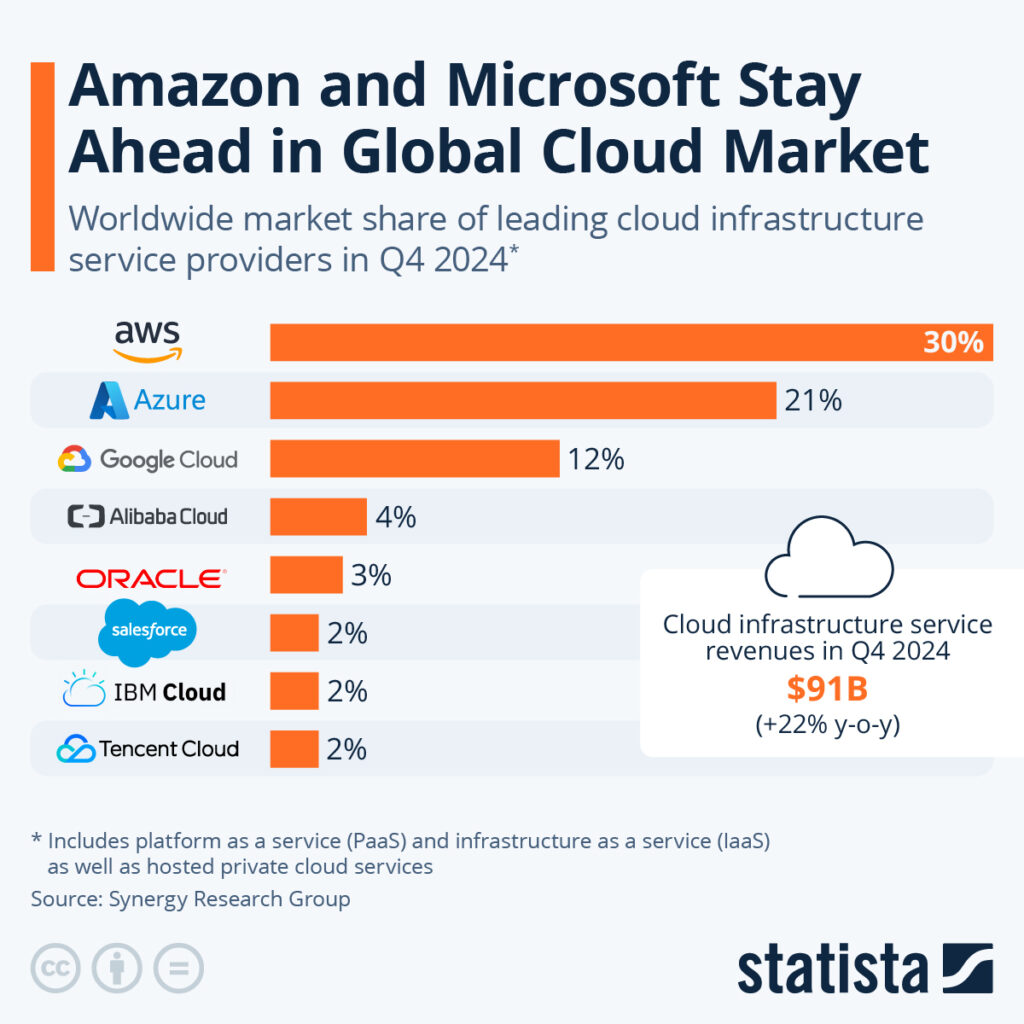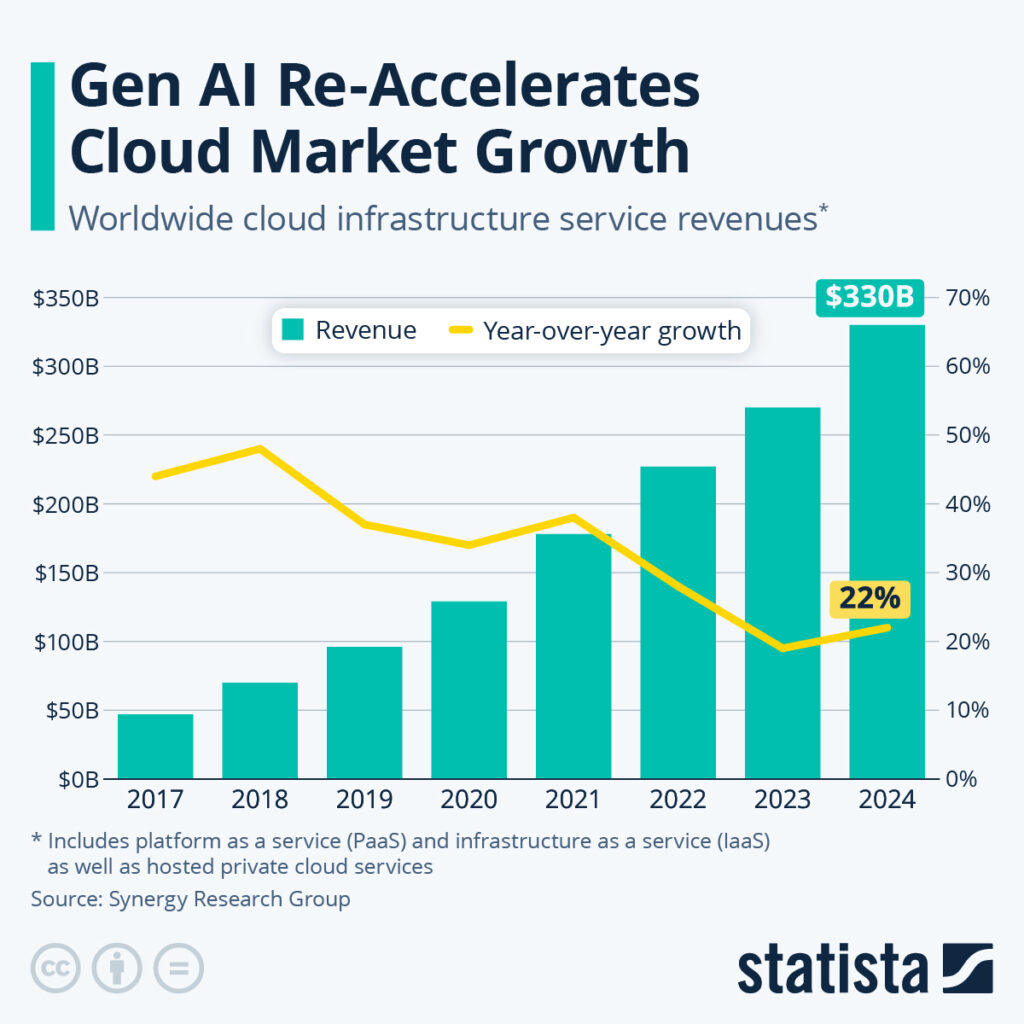By Mariana Meneses
The internet was once imagined as a decentralized frontier for innovation and free expression. But fast-forward three decades later to today, and a few tech giants dominate critical infrastructure, shaping everything from data flows to public services.
Domination of the cloud computing market by a handful of companies is highlighted in the table below. Amazon Web Services (AWS), Microsoft Azure, and Google Cloud collectively hold most of the global cloud infrastructure market, and power not only business operations but also essential public services—governments, schools, hospitals—all increasingly reliant on infrastructure they don’t own.

Image: Statista
Amazon Web Services (AWS) remains the top player in the global cloud infrastructure market, holding a 30% share at the end of 2024, followed by Microsoft Azure with 21% and Google Cloud with 12%, according to Synergy Research. These three U.S.-based giants dominate over 60% of the market, which reached $91 billion in spending during the last quarter of 2024 and totaled $330 billion for the year.
Despite its already large size, the market is expanding rapidly, driven largely by rising demand for AI-related services, creating a cycle of growth fueled by innovation and reinvestment.
This creates a problem of digital sovereignty—the ability of governments, organizations, and people to control their own digital infrastructure, data, and decision-making processes. When critical services rely on foreign-owned cloud platforms, there’s increased vulnerability to surveillance, data breaches, policy shifts, and geopolitical tension. For instance, if a tech giant changes its terms of service or faces legal pressure in its home country, governments elsewhere may be forced to comply or lose access to essential tools.
This dependence raises urgent questions: Who owns our data? Who controls our systems? And what happens when those interests no longer align with the public good?
The rise of artificial intelligence intensifies these concerns, as it drives unprecedented growth in cloud infrastructure and reinforces concentration in the hands of a few.

Generative AI fuels rapid expansion despite the cloud market’s maturity. Image: Statista
The cloud infrastructure market surged to $330 billion in 2024, largely driven by the growing demand for generative AI services, which helped re-accelerate growth to 22% despite the market’s maturity.
Since the launch of ChatGPT, AI has been responsible for about half of the revenue increase, according to Synergy Research. Amazon Web Services (AWS) maintained its lead with a 30% market share, generating around $100 billion in revenue and $40 billion in operating profit—nearly 60% of Amazon’s total. Microsoft Azure remains a strong second in this rapidly expanding and profitable sector.

Image: Statista
As the image above shows, cloud computing has become a cornerstone of Microsoft’s business, accounting for 55% of its $118.5 billion revenue between July and December 2023. This marks a steady rise from 41% in 2021, driven by the shift to cloud solutions and Microsoft’s deepening partnership with OpenAI. The integration of GPT-4 across products like Windows 11, Microsoft 365, GitHub, and Bing, alongside hosting OpenAI’s services on Azure, has significantly boosted cloud-related revenue. As global spending on public cloud services is expected to reach $679 billion in 2024, Microsoft’s cloud operations are poised to play an even more central role.
CloudZero reports that cloud computing has become nearly universal, with over 90% of organizations using some form of cloud service and more than 94% of enterprises with 1,000 and more employees relying heavily on it. Adoption is growing across all sectors, including small businesses, where 44% of traditional firms and 66–74% of tech-focused companies and enterprises use cloud infrastructure.
A majority of organizations now operate in public or private clouds, and nearly half plan to migrate at least half of their applications to the cloud within a year.
As cloud-first and cloud-native strategies rise, only a small fraction (5%) consider reverting to on-site systems. The global cloud market, projected to exceed $1 trillion by 2028, remains dominated by the U.S. and Western Europe, which together account for 82% of worldwide adoption.
Moreover, CloudZero explains that cloud adoption is gaining momentum in developing regions, with 40% of organizations actively planning or evaluating cloud strategies, according to Oracle and IDC.
According to this data, 30% of respondents in areas like Sub-Saharan Africa and Central and Eastern Europe are already using cloud services. Among larger companies, half of those with over 2,500 employees and 41% of mid-sized firms (1,000–2,500 employees) are exploring cloud solutions, signaling rapid growth beyond traditionally dominant markets.
CloudZero also shows that, despite the growing shift to cloud computing, over 20% of organizations admit they have little insight into their cloud-related costs. Still, cloud modernization remains a key focus, with integrating apps into public cloud environments seen as a top priority for the next three years. Migrating to the public cloud can reduce total ownership costs by up to 40%, making it an attractive move.
Meanwhile, 80% of organizations are already operating in multi-cloud environments, navigating vast amounts of data generated daily—an estimated 2.5 quintillion bytes worldwide.
The digital sovereignty debate intensifies.
In the journal Internet Policy Review, in 2020, Julia Pohle, from the Berlin Social Science Center, and Thorsten Thiel, from the Weizenbaum Institute, argue that the concept of digital sovereignty has become central in political discourse as states respond to the challenges of digital transformation. Once thought incompatible with the borderless nature of the internet, sovereignty is now being reasserted in various ways.
In the journal Geopolitics, in 2023, scholars describe how digital sovereignty is being redefined in response to geopolitical, economic, and technological shifts. The authors argue that digital sovereignty is not a fixed legal notion but a dynamic and contested political discourse shaped by different national and regional strategies. Through case studies such as Russia’s attempts to create a sovereign internet and the EU’s push for strategic autonomy via projects like Gaia-X and AI regulation, the article highlights how states and actors grapple with controlling digital infrastructures, data flows, and platforms.
Three main concerns dominate:
- State autonomy, where governments seek control over digital infrastructure and data, often invoking national security and leading to data localization measures;
- Economic independence, where countries, particularly in Europe, aim to reduce reliance on dominant foreign tech companies and promote local innovation, as seen in projects like Gaia-X; and,
- Individual self-determination, especially in democratic contexts, which emphasizes empowering citizens through digital literacy, privacy rights, and user control over personal data.
Led by France and Germany, Gaia-X is “A secure, federated system that meets the highest standards of digital sovereignty while promoting innovation. An open, transparent digital ecosystem, where data and services can be made available, collated and shared in an environment of trust and based on European values. A project initiated by Europe for Europe.” (GAIA-X – European Union, 2020 – pdf)
These approaches reveal that digital sovereignty is less about legal authority and more about a normative and strategic discourse, shaped by political goals, security concerns, and the dynamics of global digital governance.
Oxford philosopher Luciano Floridi goes further. In an Editor’s Letter published in the journal Philosophy & Technology, from Springer Nature, in 2020, and titled “The Fight for Digital Sovereignty”, Floridi argues that digital sovereignty is a pressing issue not just for experts but for society as a whole, as control over digital infrastructure, data, and services increasingly shapes global power dynamics.
Using real-world cases—from contact tracing apps to TikTok bans and the EU-US data transfer dispute—Floridi illustrates how states and corporations vie for dominance in the digital sphere. He critiques the rise of de facto corporate digital sovereignty, where tech giants act as private governments, and stresses the need for democratic oversight and regulation. He advocates for a hybrid model of digital sovereignty in the EU, combining national and supranational control to ensure legitimacy, cooperation, and accountability.
Ultimately, he warns that the outcome of this struggle will have profound implications for democracy, autonomy, and global governance in the digital age.
Reclaiming Control: The Rise of Self-Sovereign Identity
A 2023 article published in the journal ACM Computing Surveys, by Kheng Leong Tan and co-authors, reports on a comprehensive survey that explores the evolving concepts of data sovereignty and digital sovereignty, emphasizing the growing demand for individual control over personal data in the digital age.
As digitization and digitalization transform economies and societies, vast amounts of user data are collected—often by large tech companies—with limited user control. The paper outlines the distinction between data sovereignty (often tied to indigenous rights and local data governance) and digital sovereignty (the broader concept of autonomy over digital infrastructure, platforms, and identity). It highlights Self-Sovereign Identity (SSI) as a key model for individual digital sovereignty, where users manage their own digital identities without reliance on centralized authorities.
The authors conduct a systematic literature review, mapping out the principles, components, technical challenges, and real-world applications of SSI across domains like finance, healthcare, IoT, and e-government. They argue for robust, user-centric digital identity systems, aligned with privacy, security, and legal standards to empower both individuals and nations in reclaiming sovereignty over digital life.
Guarding against Big Tech dominance is a democratic imperative.
Cutting reliance on Big Tech is not about rejecting innovation—it’s about ensuring democratic control, resilience, and freedom in a digital world. The science and policy communities are exploring alternatives: open-source platforms, national clouds (such as the Oracle EU Sovereign Cloud and the Meghraj – the Cloud Computing initiative of the Government of India) and regional data regulation frameworks.
As a potential $200 billion AI data center project of Mark Zuckerberg’s Meta may be underway, the road to true digital sovereignty is long—and it starts with recognizing the scale of the challenges.
Craving more information? Check out these recommended TQR articles:
- Are AI Agents the Next Step Towards Artificial General Intelligence?
- Breakthroughs in Teleportation and Topological Qubits Bring Quantum Computing Closer to Reality
- Protecting Sensitive Financial Information From Data Brokers is a Crucial Government Responsibility
- Watt Matters: Addressing the Energy Problem in Data Centers
- The Gold For The Gold-Standard: the State of Science Funding Worldwide








